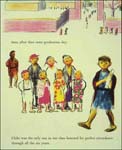Creating Meaning in a Picturebook - Part II
C. Visual Metaphor
Illustrations can serve as visual metaphors for the story. As you turn the pages in Where the Wild Things Are, you may notice that the illustrations begin very small, a page with wide, empty margins. As Max's adventure grows, so do the illustrations, until they encompass an entire double-page spread. As Max makes his way back home, the illustrations get smaller and smaller, until the last page has no picture at all.
![]() Take a look at
your copy of Where the Wild Things Are to see these concepts demonstrated.
Take a look at
your copy of Where the Wild Things Are to see these concepts demonstrated.
D. Convey the Basic Mood
Illustrations can convey the basic mood of the story. Dawn, by Uri Shulevitz, is a pastoral story of a child and grandparent camping. The night is calm, and the lake is quiet. Even the mountain seems at peace. Shulevitz creates a sense of quiet and peace with the muted watercolors and the round shapes he uses in making the pictures.
![]() Go to the Web Resources link for Dawn to see the cover image and get more
information.
Go to the Web Resources link for Dawn to see the cover image and get more
information.
E. Establishing and Developing Characters
Pictures can show character development.![]() Go to the Web Resources link for No, David! to see images and get more information.
Go to the Web Resources link for No, David! to see images and get more information.
We can immediately see from the way David looks, especially his pointed teeth, that he is capable of great naughtiness.
Now look at Crow Boy by Taro Yashima. This is the story of Chibi, who begins school as a young, frightened and shy boy. We can see this in the first opening as we see Chibi cowering under his desk. His desk is physically separated from the other children's desks, suggesting isolation from the other children. The top of his desk is red. Red is a strong, intense color and it evokes a different feeling about Chibi than the one evoked by the yellow- topped desks of the other children. Chibi is also one the lower part of the page, the teacher and the other children tower above him.

(As with all images in your lessons, click anywhere on the image above to see it in full view.)
Now look at this illustration from near the end of the book. Chibi is older now. He has the respect of his peers and his teacher. His body is straight, his head is up. His head is also on the same level as the other children's, who cast their eyes upward toward Chibi. Just comparing these two pictures shows us that Chibi is a different boy from the one we first met.
